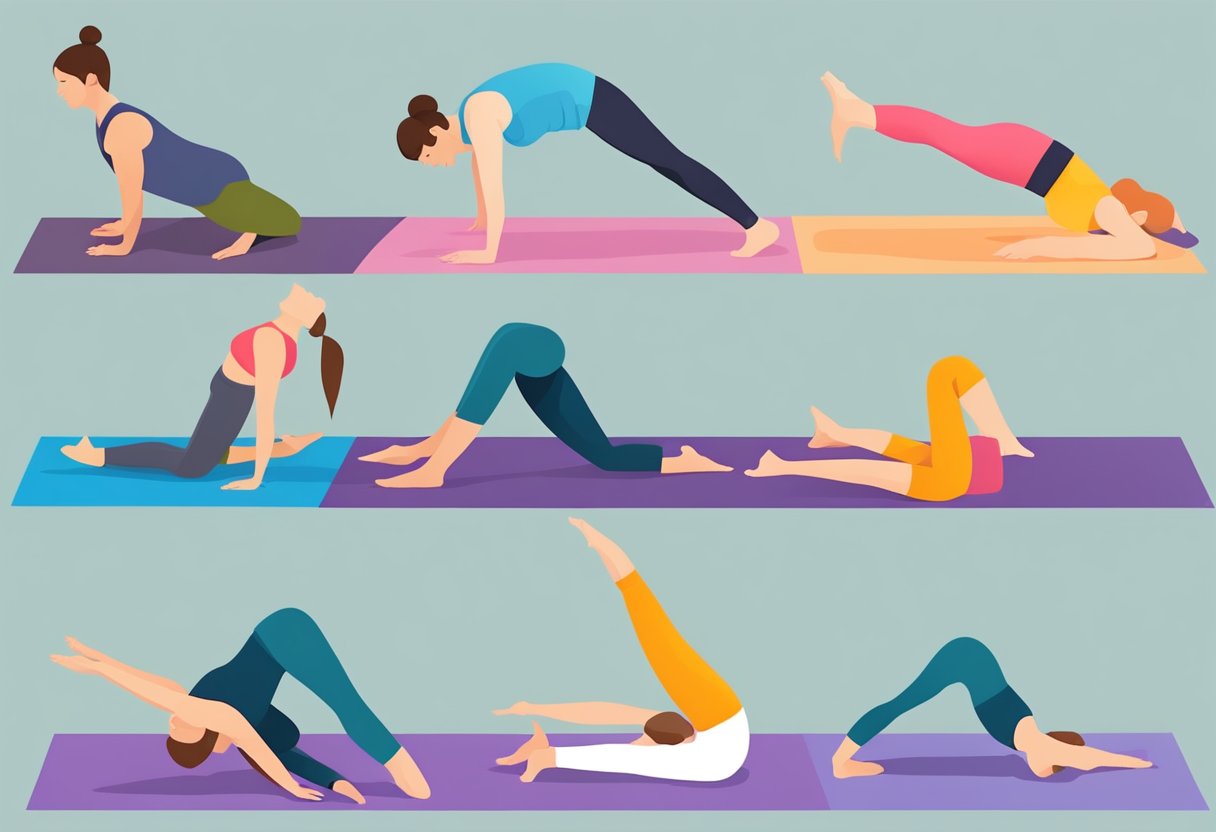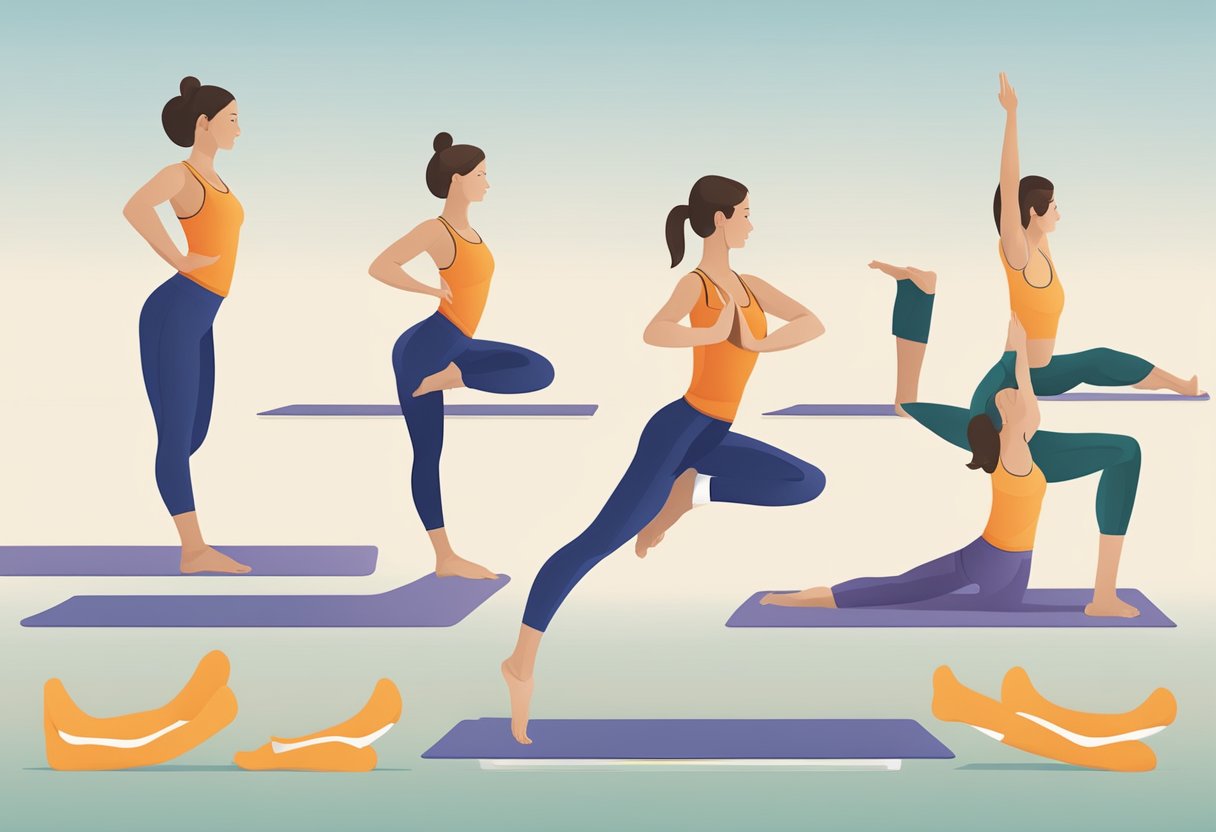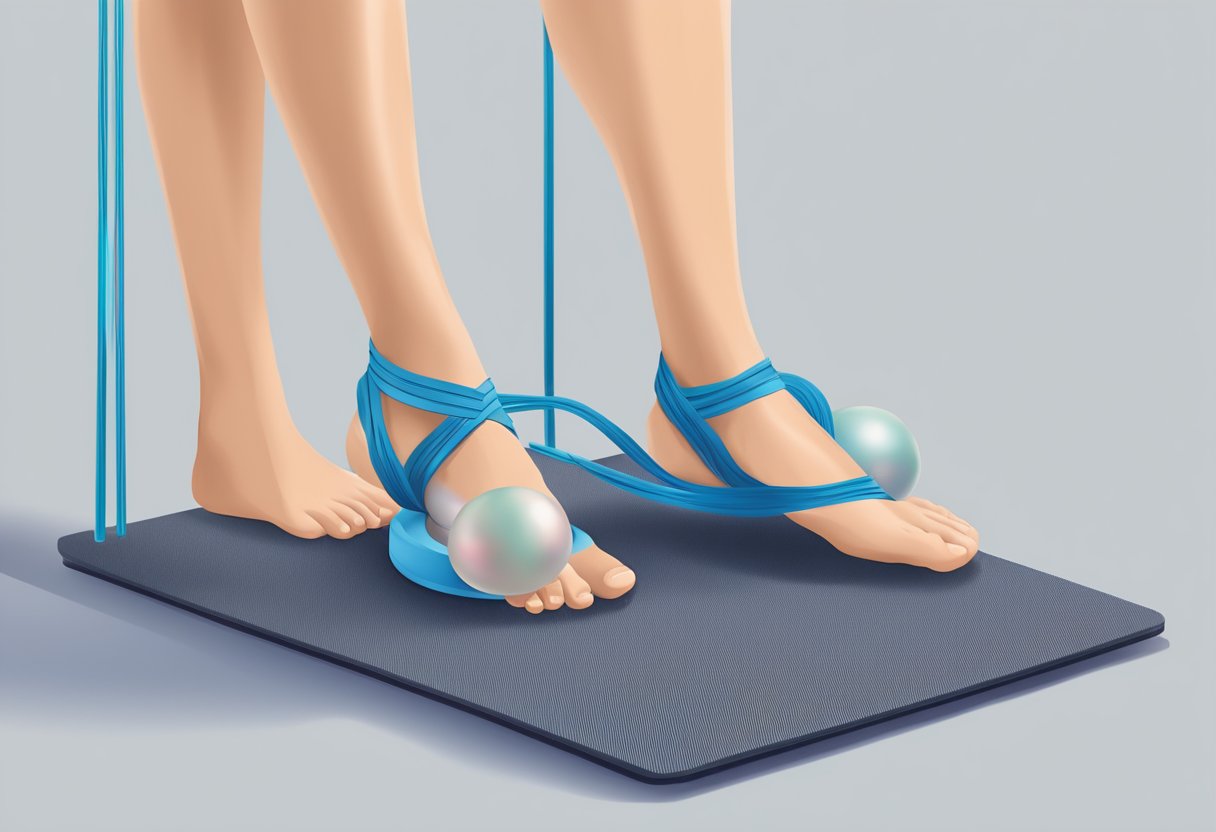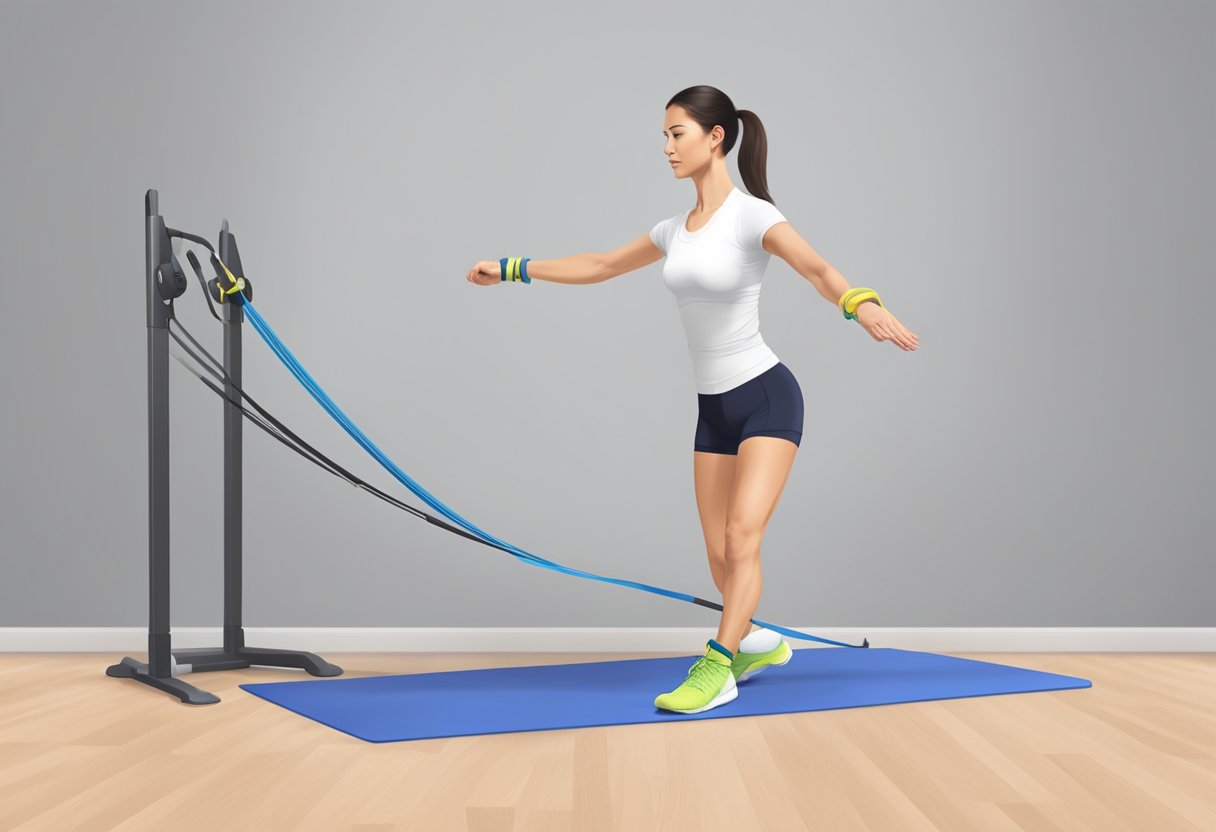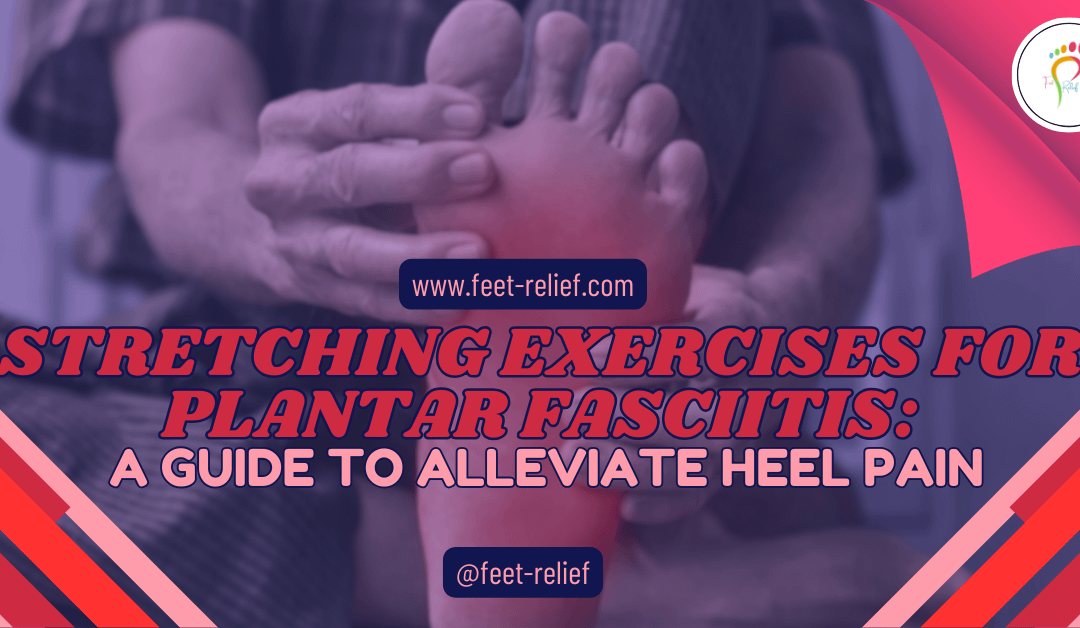
foot care, foot problems, neuropathy, pain
Yoga Poses for Strengthening and Stretching the Feet
Yoga is a practice that not only benefits the mind and core body muscles but also targets smaller, often-neglected areas such as the feet. Incorporating yoga poses that focus on strengthening and stretching the muscles, tendons, and ligaments in the feet can enhance overall foot health, reducing the risk of injuries and improving balance and stability. Understanding the complex anatomy of the foot is the first step in recognizing how yoga can contribute to stronger, more flexible feet. Feet issues? Try Yoga Poses for Strengthening and Stretching the Feet.

Before engaging in targeted foot exercises, it’s crucial to warm up adequately to prepare the body for more intensive stretching and strengthening. Just like any other part of the body, the feet need to be eased into practice to prevent strain or injury. Both basic and advanced yoga poses can be utilized to build the strength and flexibility of the feet, while restorative poses aid in releasing tension and promoting relaxation and recovery. Implementing a routine inclusive of foot-focused yoga poses can have long-lasting benefits for physical conditioning, not just for your yoga practice but for your daily activities as well.
Key Takeaways
Understanding Foot Anatomy and the Importance of Strength and Flexibility
Your feet are a complex structure designed to provide support, balance, and mobility. They consist of 26 bones, over 30 joints, and more than 100 muscles, tendons, and ligaments. This intricate design allows your feet to bear the weight of your entire body. To maintain foot health, both strength and flexibility are vital.
Strength is crucial for:
To develop strength in your feet, incorporate yoga poses that require you to balance on one foot, like the Tree Pose, or that involve spreading and lifting your toes.
Flexibility helps with:
- Preventing injuries
- Ensuring proper alignment
- Facilitating a full range of motion
Stretching exercises and yoga poses like toe separators can improve your feet’s flexibility.
Remember, your feet are the foundation for all standing yoga postures. Maintaining their strength and flexibility is not just critical for your yoga practice but also for your overall well-being. Regularly including foot-specific yoga sequences into your routine can significantly enhance the stability and mobility of your feet.
Essential Warm-Up Exercises Before Practicing Yoga

Before diving into your Yoga Poses for Strengthening and Stretching the Feet, it’s crucial to prepare your body to prevent injury and to enhance your overall experience. Start with a warm-up routine focusing on mobility and gentle stretching to get the blood flowing to your muscles and joints.
- Child’s Pose (Balasana): Begin on all fours, then lower your hips back to your heels, and stretch your arms forward. This pose relaxes your lower back and stretches the feet.
- Mountain Pose (Tadasana): Stand with your feet together, toes spread wide. Feel the balance and grounding through your feet, which will form the foundation for your practice.
For your feet, in particular, perform these targeted exercises:
- Toe Stretch:
- Sit with your knees bent and toes curled under.
- Gently press into the toes to stretch the foot’s underside.
- Ankle Rolls:
- Lift one foot, roll the ankle clockwise for a few breaths, then switch to counterclockwise.
- Repeat with the other foot.
Remember to take slow, deep breaths and allow your body to ease into each movement. Aim for about 5-10 repetitions of each ankle roll per foot. Being mindful of these details will set a positive tone for your session and could greatly improve your focus on foot strengthening and stretching during your yoga practice.
Basic Yoga Poses for Foot Strengthening
When practicing yoga, your feet form the foundation of many postures, making foot strength crucial for balance and stability. Here are some basic poses aimed at improving the strength of your feet:
- Mountain Pose (Tadasana): This pose may seem simple, but it’s an effective way to build a connection with the ground. Ground down through the soles of your feet, evenly distributing your weight and engaging the muscles in your legs and feet. This foundational stance sets the tone for foot strength.
- Downward Facing Dog (Adho Mukha Svanasana): This well-known pose not only stretches your hamstrings and back but also strengthens your feet as you press through your heels, aiming to reach the mat.
- Warrior Pose (Virabhadrasana): All variations of the Warrior Pose require balance and strength from the feet. Focus on stabilizing yourself through the foot of your front leg, with your weight evenly spread across the heel and balls of the foot.
- Toe Squat: From kneeling, tuck your toes and sit back on your heels. Your body weight creates resistance, helping to strengthen your toes and the arches of your feet.
- Thunderbolt Pose (Vajrasana): By sitting back on your heels with the tops of your feet stretched out on the floor, you engage and reinforce your foot muscles, especially if maintaining the pose for several breaths.
Incorporate these poses into your yoga practice regularly to build and maintain foot strength. Remember, balance and precision in these poses can help improve overall foot health and support your yoga journey.
Advanced Yoga Poses for Enhancing Foot Strength
To increase strength in your feet, practicing certain advanced yoga poses can be highly beneficial. Given the complex structure of the foot, which includes bones, muscles, and ligaments, these poses aid in improving both flexibility and stability, which are vital for balance and overall foot health.
Vasisthasana (Side Plank Pose): This pose requires you to balance on one arm and the outside of one foot, helping to strengthen the muscles along the side of the foot and ankle.
- Begin in a traditional plank position.
- Shift your weight onto your right hand and outer right foot.
- Stack your left foot on top of the right with your legs straight.
- Extend your left arm up towards the sky.
Natarajasana (Dancer’s Pose): A test of balance, this pose encourages concentration and strengthens the small muscles in your feet.
- Stand on your right foot, bend your left knee and grab the inside of your left foot with your left hand.
- Stretch your right arm forward for balance, as you push your left foot into your hand, lifting it up and back.
Padangusthasana (Big Toe Pose): This forward bend engages the toes and stretches the muscles and tendons of the feet.
- Stand upright, then hinge at the hips to fold forward.
- Catch your big toes with your index and middle fingers.
- Pull up on your toes as you press the balls of your feet down.
For descriptions of practicing these poses and additional foot-strengthening sequences, the resources provided by Yoga Journal can be invaluable. Remember, consistency is key, and careful attention to technique will ensure the best results.
Yoga Poses Focused on Foot Stretching
Practicing yoga can greatly benefit the health of your feet, which are fundamentally important for balance and alignment. To focus on stretching your feet, include these effective poses in your routine.
- Downward Facing Dog Pose: Essential for stretching the feet, especially the plantar fascia. Begin on all fours, tuck your toes, lift your hips, and press back into an inverted “V” shape. Push your heels towards the ground for a deep stretch.
- Mountain Pose: A subtle but effective foot stretcher. Stand upright with your feet together and firmly plant them on the ground. Lift your toes, spread them apart, and then press them back down to enhance the stretch in the arches.
- Thunderbolt Pose: Sit on your heels with your knees bent and hands resting on your thighs. Your toes will be stretched, and as you shift your weight back slightly, the stretch intensifies. Hold this position for a minute or more for a thorough foot stretch.
- Extended Hand to Big Toe Pose: A challenging balance that not only stretches your feet but also your legs and improves stability. Stand on one foot, hold the big toe of the other foot with your hand, and stretch the held foot forward, keeping your spine long and chest open.
Incorporating these poses into your yoga practice can lead to increased flexibility and strength in your feet. For more detailed instructions and benefits, check out the focused approaches on Yoga Journal and techniques from Well+Good. Remember to approach each pose mindfully and within your comfort level to avoid any strain or injury.
Sequences and Flows for Comprehensive Foot Workouts

To bolster your foot strength and flexibility, engage in yoga sequences designed to target the feet. By practicing these specific flows and poses, you can enhance your balance and build a robust foundation.
Yoga Poses for Strengthening and Stretching the Feet
Key Poses to Incorporate:
- Toe Spread and Squeeze: Spread your toes wide, then squeeze them together. This simple motion helps to increase control over your toe muscles.
- Heel Raises: Transitioning from flat feet to tiptoes strengthens your foot arches and calves.
Flow Sequence:
- Mountain Pose: Ground your feet. Focus on evenly distributing your weight.
- Downward-Facing Dog: Elevate your hips to stretch your feet’s soles.
- Warrior I to Warrior III: Move through these poses to challenge your balance and foot stability.
Yoga sequences for strong feet can emphasize transitions that promote foot strength, such as from standing poses to one-legged balances.
Foot-Specific Exercises:
- Foot Rolls: Use a tennis ball underfoot to massage and release tension.
- Ankle Rotations: Clockwise and counter-clockwise to improve ankle mobility.
Incorporating a combination of static poses and dynamic movements in your practice will yield the best results for foot health. Visit 10 Yoga Sequences for Strong Feet and Better Balance for guided practices and further instruction. Integrating these techniques regularly into your routine will strengthen and stretch your feet, improving your overall yoga practice.
Restorative Yoga Poses to Relieve Foot Tension
When your feet feel weary after a long day, restorative yoga can help alleviate the tension. Try these poses aimed specifically at easing your foot discomfort.
Reclining Hand-to-Big-Toe Pose
With the assistance of a yoga strap, perform Reclining Hand-to-Big-Toe Pose to stretch and relax your feet. Lie on your back and loop the strap around your foot. Straighten your leg to a comfortable position and hold for a few minutes before switching to the other foot. This pose encourages blood circulation and stretches the muscles on the soles of your feet.
- Toe Squat
Enter a kneeling position and curl your toes under, sitting back on your heels. Hold this pose for 1-2 minutes to stretch the plantar fascia and the toes. Release gently if you feel any sharp pain.
- Legs Up the Wall
Position yourself with your legs extended up a wall while lying on your back. Support your lower back with a bolster or folded blanket. Remain in this pose for 5-10 minutes. The elevation helps in reducing swelling and fatigue in the feet.
Supported Bridge Pose
Place a yoga block or bolster under your sacrum in a supported bridge position, allowing your feet to rest comfortably on the mat. This pose can soothe tired feet and also release tension in the lower back.
Remember to breathe deeply and focus on the sensation of relief in your feet as you transition through these poses. Each restorative posture is designed to help decompress and bring restful awareness to your feet.
Tips for Safe Practice and Preventing Injury While Strengthening Feet
When engaging in yoga poses aimed at strengthening and stretching the feet, it’s important to practice safely to prevent injury. Here are some tips to keep in mind during your practice:
- Warm Up Properly: Before diving into foot-specific poses, ensure that your entire body is warmed up. This increases circulation to your feet, preparing them for exercise.
- Mind Your Alignment: Maintaining proper alignment is crucial. Your knees and feet should be in line, as this helps distribute your weight evenly and prevents undue stress on your feet.
- Don’t Overstretch: Pay close attention to the sensations in your feet. If you feel pain or excessive strain, ease up. It’s better to gradually build flexibility than to force your feet into positions.
- Use Props for Support: Props like yoga blocks or straps can provide additional support and help you achieve the right posture without overexertion.
- Build Strength Gradually: As with any strength training, start with simpler poses and progress to more challenging ones over time. This incremental approach develops sustainable foot strength.
- Cool Down: After your session, perform stretches to relax the muscles in your feet, like the toe squat or foot stepover, which aid in recovery.
- Stay Consistent: Regular practice yields the best results. However, listen to your body and take rest days as needed.
Remember, everyone’s body is different, and these tips are not a substitute for professional advice. If you have pre-existing conditions or feel unsure about a pose, consult with a yoga instructor or healthcare professional. Your safety is paramount in your journey towards stronger, more flexible feet.
Integrating Foot Yoga Poses into Your Daily Routine
Incorporating foot yoga into your daily regimen can enhance your balance and fortify the muscles in your feet. Start by setting aside just a few minutes each day, gradually building a routine that fits seamlessly into your lifestyle.
Morning Activation: Upon waking, before even getting out of bed, flex and point your toes. These simple motions awaken the feet and can be a gentle start to your day. Consider practicing toe separation exercises, which can improve your toe’s dexterity.
Midday Pick-me-up: Take a short break from work or activities to stretch your feet. A discreet and effective pose is the Toe Squat, which entails kneeling and then tucking your toes under, sitting back on your heels to stretch the soles and toes of your feet. Hold this toe stretch for 30 seconds to a minute for a refreshing midday revival.
- Desk Work: While sitting, roll a small ball under each foot. This can help release tension and improve circulation, especially if you spend long hours stationary.
Evening Wind-down: As part of your evening routine, integrate more restorative foot poses. The Reclined Hero Pose or Vajrasana variation can aid in stretching the tops of the feet and ankles.
| Time of Day |
Yoga Pose |
Duration |
Benefit |
| Morning |
Toe Flexion & Extension |
2-3 mins |
Activation and Awareness |
| Midday |
Toe Squat |
1-2 mins |
Tension Release, Flexibility |
| Evening |
Reclined Hero Pose |
3-5 mins |
Stretching, Relaxation |
Remember to listen to your body and avoid overexerting your feet. With consistent practice, these yoga poses can become building blocks for healthier feet, enhanced balance, and overall well-being.
Frequently Asked Questions
Yoga Poses for Strengthening and Stretching the Feet
Yoga can significantly enhance your foot health, providing strength, flexibility, and pain relief through targeted poses and stretches. The following FAQs address common concerns and the most effective yoga practices for feet.
What are the best yoga poses to promote foot strength?
To build foot strength, you can start with poses such as Toestand, which can improve your balance and core strength, along with stability in your ankles and hips.
Which yoga exercises can help alleviate plantar fasciitis?
Yoga exercises that stretch the plantar fascia and strengthen foot muscles, like toe curls and arch lifts, can be beneficial for alleviating plantar fasciitis.
How can yoga be used to stretch and relieve foot and calf tension?
Poses like Downward-Facing Dog can stretch and relieve tension in your feet and calves. Incorporating heel lifts and ankle rotations into your practice can also promote flexibility and reduce tightness.
Can practicing foot yoga assist in reducing bunions?
While yoga cannot cure bunions, it can help manage their symptoms. Gentle stretching and strengthening exercises for your feet might improve alignment and offer bunion relief.
What are the benefits of incorporating toe stretches in a yoga routine?
Incorporating toe stretches can increase your toes’ flexibility and strengthen the muscles in your feet, which may enhance overall balance and stability in your yoga practice.
Are there specific yoga poses that target flexibility and muscle tone in the feet?
Yes, Extended Triangle Pose is one of many yoga poses that can target both flexibility and muscle tone in the feet. Various standing and balancing poses also engage the feet and contribute to stronger, more flexible muscles.
You Might Also Like
Tips For Practicing Self-Care For Your Feet
Foot Arch Pain Exercises: Effective Relief
Foot Arch Pain Exercises: Effective Relief Strategies for Sore Feet
Calf Stretches for Foot Health: A Comprehensive Guide
The Benefits of Toe Yoga: A Guide to Enhancing Foot Health
foot arch, foot problems
The arch of the foot plays a crucial role in your overall foot health, affecting balance, gait, and posture. Strengthening the arch can lead to improved foot function and prevent injuries. Whether you’re an athlete looking to enhance performance or someone facing foot pain due to fallen arches or flat feet, exercises targeting the arch can be beneficial. Building arch strength can alleviate discomfort, provide better support for your body, and contribute to a more active lifestyle.

Beginning an exercise regimen for your foot’s arch should be approached with an understanding of your current foot health. Knowing the anatomy of your foot and assessing your arch’s strength can greatly influence the effectiveness of your exercise routine. Simple exercises can be done at home with minimal to no equipment, while more advanced techniques and exercises may incorporate tools like resistance bands or stability balls to further challenge the muscles supporting the arch.
Key Takeaways
- Strengthening the foot arch can improve balance and prevent injuries.
- Assessing arch health is crucial before starting exercises.
- Exercise progression from basic to advanced techniques enhances arch strength.
Anatomy of the Foot Arch

Your foot arch is a complex and critical structure that plays a key role in your overall foot health and function. It is made up of bones, ligaments, and muscles that work together to allow your foot to support the weight of your body while providing flexibility and movement.
Bones: There are three main bones that form the arches of your foot:
- Talus: Sits above the heel bone and forms the ankle.
- Calcaneus (heel bone): The largest foot bone that forms the heel.
- Metatarsals: Long bones at the front of your foot.
Ligaments: Think of ligaments as strong bands that hold the bones together and provide stability. Prominent ligaments in the foot arch include:
Muscles: Your foot contains intrinsic and extrinsic muscles. The intrinsic muscles are located within the foot and are responsible for fine motor control, while the extrinsic muscles originate in the lower leg and are attached to the foot through tendons. Important muscles and tendons for the arch include:
- Posterior tibial tendon: Supports the arch.
- Anterior tibial tendon: Allows you to lift your foot.
- Peroneal tendons: Stabilize the foot and protect the arch.
Ideal maintenance of this intricate system is crucial for your mobility and comfort. Regular exercises can strengthen these components, helping to prevent or alleviate problems such as fallen arches or plantar fasciitis.
Benefits of Arch Strengthening
Strengthening the arches of your feet is critical to your overall foot health. The benefits are numerous and can lead to improved foot function in several ways:
-
Support and Stability: A stronger arch helps support the body’s weight, enhancing stability and balance. Your arches act as natural shock absorbers, and reinforcing them can lead to improved performance in activities that require agility and coordination.
-
Injury Prevention: By engaging in exercises to strengthen the arch, you’re less likely to experience common foot injuries. This preventative measure is particularly important for athletes or individuals with a history of foot problems.
-
Pain Relief: Many foot-related discomforts, such as plantar fasciitis and heel pain, can be alleviated by strengthening the muscles around the arch. Stronger arches can also help in reducing the strain on the Achilles tendon.
-
Improved Posture: Your feet are the foundation of your body. A stronger arch contributes to better alignment of your legs and spine, promoting better posture overall.
-
Enhanced Foot Mechanics: Strengthening your arch can improve the mechanics of how you walk and run, potentially leading to increased efficiency and reduced fatigue in your lower extremity muscles.
Incorporating arch-strengthening exercises into your daily routine is simple and can provide long-term benefits. For example, the Short Foot Exercise is highly effective, as it targets the small muscles that support the arch, and can be done almost anywhere without the need for special equipment. Remember, just like any other part of your body, the muscles in your feet need exercise to remain strong and perform their best.
Assessment of Arch Strength
Proper assessment of your arch strength is the foundation for a successful foot strengthening routine. Begin by inspecting your foot architecture—notice if you have a well-defined arch, flat feet, or high arches. This visual check provides a preliminary understanding of your foot type.
Visual Inspection:
- Stand barefoot and observe your arch in a mirror.
- Note whether the inner part of the foot is lifted off the ground or if it’s flat against the surface.
Wet Test:
- Wet your feet and step onto a dry surface to imprint your foot shape.
- A complete imprint may indicate low arches, while a missing section in the inner foot suggests higher arches.
Manual Testing:
- Attempt to move the arch muscles by flexing them without curling your toes.
For a quantitative measure, perform the Single-Leg Heel Raise:
- Stand on one foot.
- Rise onto your toes.
- Count the number of heel raises you can do before fatigue sets in.
An indicator of good arch strength is the ability to complete this exercise without pain or cramping and perform multiple repetitions with ease.
Engage in Static Arch Testing:
- Press your foot flat on the ground.
- Try to lift the arch while keeping your toes and heel on the floor.
Each of these assessments targets the ability of your intrinsic foot muscles to support your arches. Remember, consistent practice and gradual progression in exercises are key to improving your foot strength.
Starting with Basic Exercises
Beginning to strengthen the arch of your foot can be as simple as incorporating a few key exercises into your routine. These foundational movements help to build up the smaller intrinsic muscles of the feet, as well as improve overall foot mechanics.
Toe Presses
Toe Presses activate the muscles of the arch. Find a stable surface and stand upright. Progressively press your toes downward into the floor while keeping your heel in contact with the ground. Hold the press for a few seconds, then release. Repeat for 10–15 times for each foot.
Heel Raises
Heel Raises are essential for engaging the entire foot and improving ankle stability. Start with your feet hip-width apart. Gradually lift your heels off the ground, rising onto your toes. Ensure that the pressure is evenly distributed across all toes. Hold this position briefly at the top before lowering back down. Aim for 2 sets of 10 repetitions.
Arch Lifts
Finally, Arch Lifts will target the arch directly for strengthening. While standing, keep your toes flat on the floor and attempt to raise only the arch of your foot, creating a small gap between the floor and your arch. Do not roll to the outer sides of your feet. Hold the lift for a couple of seconds, then relax your arches. Perform 2 sets of 10 lifts for each foot.
Intermediate Strengthening Techniques
After mastering basic exercises for the arch of your foot, it’s time to elevate your routine with intermediate techniques. These strengthening exercises are designed to build upon your foundational strength and enhance the stability of your foot arches.
Towel Curls
To further develop the muscles in your feet, towel curls are an excellent intermediate exercise. Place a towel flat on the floor and sit on a chair with your feet on the edge of the towel. Using just your toes, scrunch the towel towards you, hold for a few seconds, and then release. This action mimics the natural gripping motion your feet employ when walking.
- Frequency: Aim to perform 3 sets of 15 curls with each foot.
Toe Splay
Toe splay exercises work on the muscles that control toe movement. Sit comfortably and rest your feet flat on the ground. Without straining, spread your toes apart as much as possible, hold the position for a moment, and then relax your toes back to the starting position.
- Repetitions: Complete 10-15 repetitions per set.
- Sets: Do 2-3 sets per session.
Through these exercises, your feet will gain better mobility and strength, which is crucial for supporting your arches.
Advanced Exercise Progressions
After establishing a foundation of foot strength, you can challenge your foot arches with advanced exercises that promote balance and power.
Single-Leg Stands
Begin by standing on a stable surface on one foot. Hold this position for one minute, ensuring that your planted foot maintains a strong arch. As your stability improves, progress to balancing on an unstable surface such as a foam pad or a balance disc. This progression will further challenge your intrinsic foot muscles and improve proprioception.
Plyometric Workouts
Incorporate jumping exercises such as box jumps or jump squats, emphasizing the need for soft landings. Start with lower heights and progress gradually. During plyometric workouts, be mindful of maintaining an engaged arch to foster strength development and mitigate the risk of injury.
Incorporating Tools and Equipment

When it comes to strengthening the arches of your feet, incorporating specific tools and equipment can enhance the effectiveness of your exercises. These aids help apply the right amount of resistance and support to progressively improve foot strength.
Resistance Bands
Resistance bands are an excellent tool for adding progressive tension to arch strengthening exercises. By looping a band around your foot, you can perform exercises such as:
- Band Pulls: Attach the band to a stationary object and pull your toes towards you.
- Point and Flex: Point your toes against the band’s resistance, then flex them back.
This direct resistance helps target the muscles in your arch more precisely.
Foot Domes
Foot domes or balance pods provide a curved surface that challenges your foot muscles. You can perform exercises like:
- Dome Presses: Stand on the dome and press your arches up and down.
- Heel Raises: While standing on the dome, lift your heels to strengthen the calf muscles and the arch.
Using foot domes during these exercises helps to improve your proprioception and balance, key components of foot health.
Exercise Routine Structure
When structuring your exercise routine for strengthening the arch of your foot, consistency and progression are vital. You’ll want to begin with a warm-up to prepare your feet for the exercises. This can involve simply walking on your toes and heels for a few minutes or rolling a ball under your feet to stimulate the muscles and tendons.
Your main routine should include a variety of exercises targeting different aspects of your foot strength.
- Short Foot Exercise: Aim to do 3 sets of 10 repetitions on each foot. Gradually increase the hold time as you progress.
- Toe Curls: Start with 3 sets of 5 repetitions and increase as your strength improves.
Between exercises, take a 30-second rest to prevent overworking the muscles.
| Week |
Short Foot Exercise |
Toe Curls |
Rest Time |
| 1 |
3×10 Reps |
3×5 Reps |
30s |
| 2 |
3×12 Reps |
3×7 Reps |
30s |
| 3 |
3×15 Reps |
3×10 Reps |
30s |
Ensure to incorporate exercises that are geared towards strengthening the intrinsic (deep) muscles in your feet, such as using your toes to pick up objects or marbles.
At the end of your workout, a cooldown is essential to help your muscles recover and prevent injury. Stretching the plantar fascia and calf muscles gently should suffice.
Remember, it’s important to pay attention to your body’s signals. If you experience any pain, stop the exercises, and consult a healthcare professional. With time and dedication, you can progressively increase the intensity and complexity of the exercises to further enhance your arch strength.
Common Mistakes to Avoid
When aiming to strengthen the arches of your feet, being aware of common errors can help you maximize the benefits of your exercises and avoid injury.
-
Not Keeping Proper Alignment: Your feet should be parallel to each other during exercises. Allowing your foot to rotate in or out can lead to improper muscle engagement.
-
Rushing Through the Movements: Slow, controlled movements ensure that the correct muscles are being activated. Rushing can cause you to rely on momentum rather than muscle strength.
-
Ignoring Pain: If you experience pain, stop the exercise. Pushing through foot pain can lead to further injury.
-
Forgetting to Stretch: Always stretch your feet before and after exercises to avoid muscle strains.
-
Overworking Your Feet: Starting with too many repetitions can lead to overuse injuries. Begin with a few reps and increase as you get stronger.
-
Neglecting Other Foot Areas: The arch is connected to other parts of the foot. Include exercises that work the toes, heel, and ankle.
-
Wearing Inappropriate Shoes: Wear supportive shoes that do not constrict your feet. Barefoot training can also be beneficial.
Remember to maintain good form and listen to your body throughout your foot strengthening routine. Improper technique can lead to ineffective training or injury. For detailed guidance, consider expertise on arch lifts in Pilates which can aid in strengthening your foot’s arch effectively and safely.
Safeguarding Against Injury

When embarking on exercises to strengthen the arch of your foot, it’s crucial to protect yourself from injury. Your arch is fundamental to your foot’s structural integrity and plays a key role in movement. Here are steps to ensure you stay safe:
Start Slowly:
- Begin with basic exercises and gradually increase intensity.
- Recognize your limits and avoid overexertion.
Proper Footwear:
- Wear supportive shoes that are appropriate for your foot type and the exercise you’re doing.
Warm-Up:
- Always warm up before starting your routine.
- Simple toe curls and foot doming can prepare your muscles for more demanding workouts.
Technique Matters:
- Focus on correct form to avoid strain.
- Take time to learn the exercises, it’s better to perform fewer repetitions correctly than more with poor form.
Listen to Your Body:
- Pain is a warning sign; stop if you feel discomfort beyond normal muscle fatigue.
- Give yourself regular rest days to allow for recovery.
Including exercises like marble pickups and arch lifts could aid in strengthening the intrinsic foot muscles and potentially prevent common overuse injuries such as plantar fasciitis. Remember, these exercises must be done with precision to build strength effectively and prevent injury.
Monitoring Progress and Adaptations
When embarking on a routine to strengthen the arch of your foot, tracking your progress is key. You’ll want to ensure that you’re making strides in your strength and stability, and adapting your exercises appropriately.
-
Initial Assessment:
Start with an evaluation of your current arch strength. Can you hold an arch lift for several seconds? Can you pick up marbles with your toes?
-
Recording Baseline:
Document how long you can perform activities like the arch lift or marble pickup. Write down the number of repetitions you can comfortably achieve.
Weekly Check-ins:
Set a weekly schedule to reassess your capabilities. Are you able to perform more repetitions? Can you hold the exercises for a longer duration?
Adapt Exercises As Needed:
If something feels too easy or too challenging, modify it. Gradually increase the difficulty by:
- Changing the number of repetitions
- Adjusting the duration of each exercise
- Incorporating new exercises, such as those involving a strength ball for your feet
Notice Changes:
Pay attention to how your feet feel during everyday activities. Improvement in arch strength can lead to less discomfort when walking or standing.
| Exercise |
Week 1 |
Week 2 |
Week 4 |
Changes Made |
| Arch Lifts |
8 reps |
10 reps |
12 reps |
+2 reps each week |
| Marble Pickup |
15 marbles |
18 marbles |
20 marbles |
+3 marbles each week |
Remember to update your plan every few weeks to ensure continuous progress. Always listen to your body and consult a professional if you’re unsure about any adaptations.
Frequently Asked Questions
In this section, we address common inquiries about enhancing the strength of the arches in your feet, from exercises that target flat feet to the benefits of ballet and the underlying causes of weak arches.
What are the best exercises to improve strength in flat feet?
Incorporating exercises like toe curls and marble pickups can be very effective in strengthening the intrinsic muscles of your flat feet.
Are there specific foot exercises recommended by the NHS for fallen arches?
While the NHS offers general advice on foot care, specific exercises such as short foot exercises and arch lifts are widely recommended by podiatrists for fallen arches.
How can runners strengthen the arches of their feet?
Runners may benefit from exercises that emphasize endurance and flexibility of the arch, including heel raises and toe stretches.
Which exercises can help to rebuild the arch in flat feet?
Exercises such as calf stretches and foot doming are effective in working toward rebuilding the arch in flat feet.
Can practicing ballet improve the arch of the foot?
Yes, the footwork in ballet requires and thus helps to build greater foot strength and arch flexibility, which can lead to an improved arch.
What are the causes of weak arches in the feet?
Weak arches can arise from a variety of causes, including genetics, injury, or conditions such as obesity and diabetes that place significant strain on the feet.

















